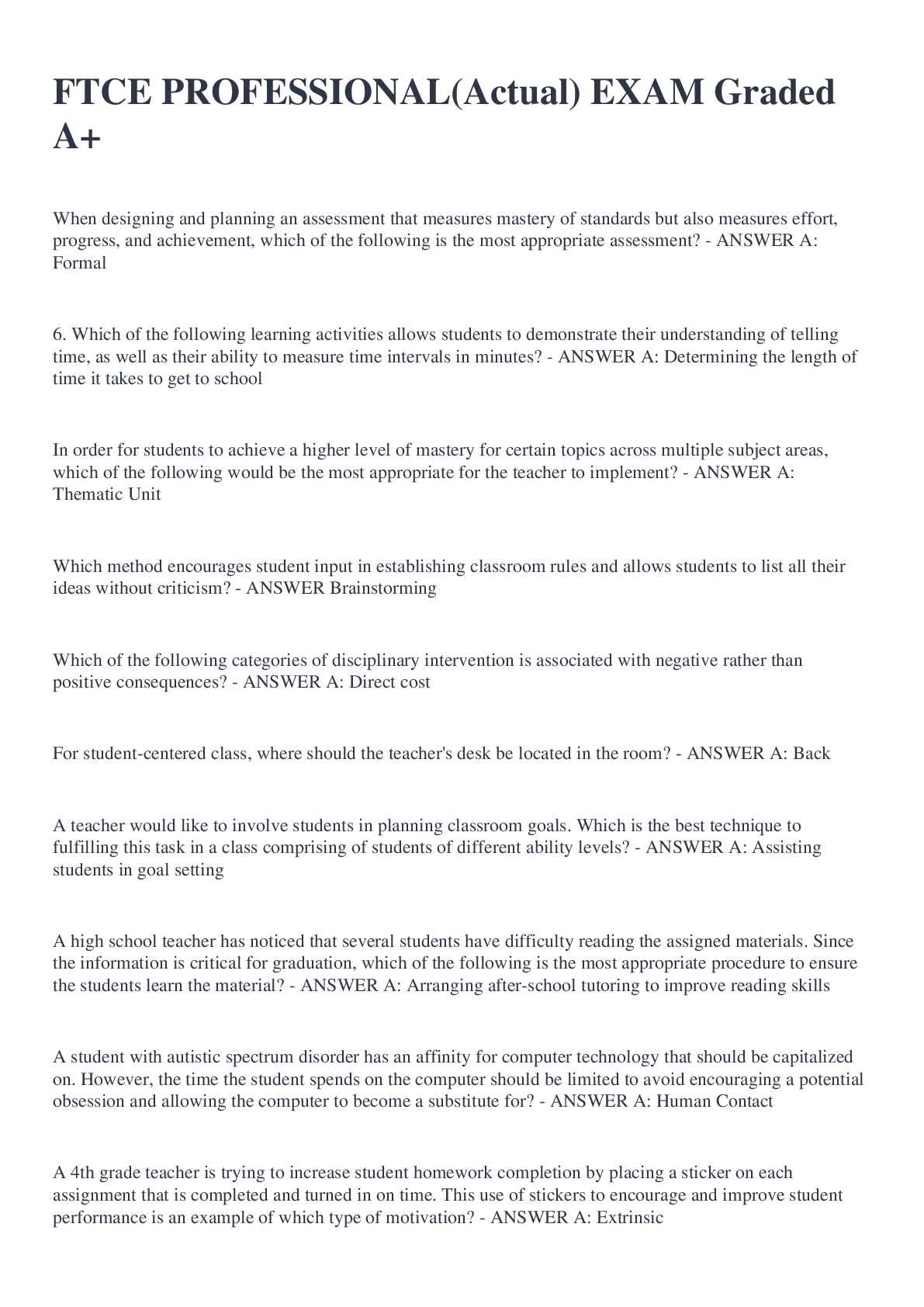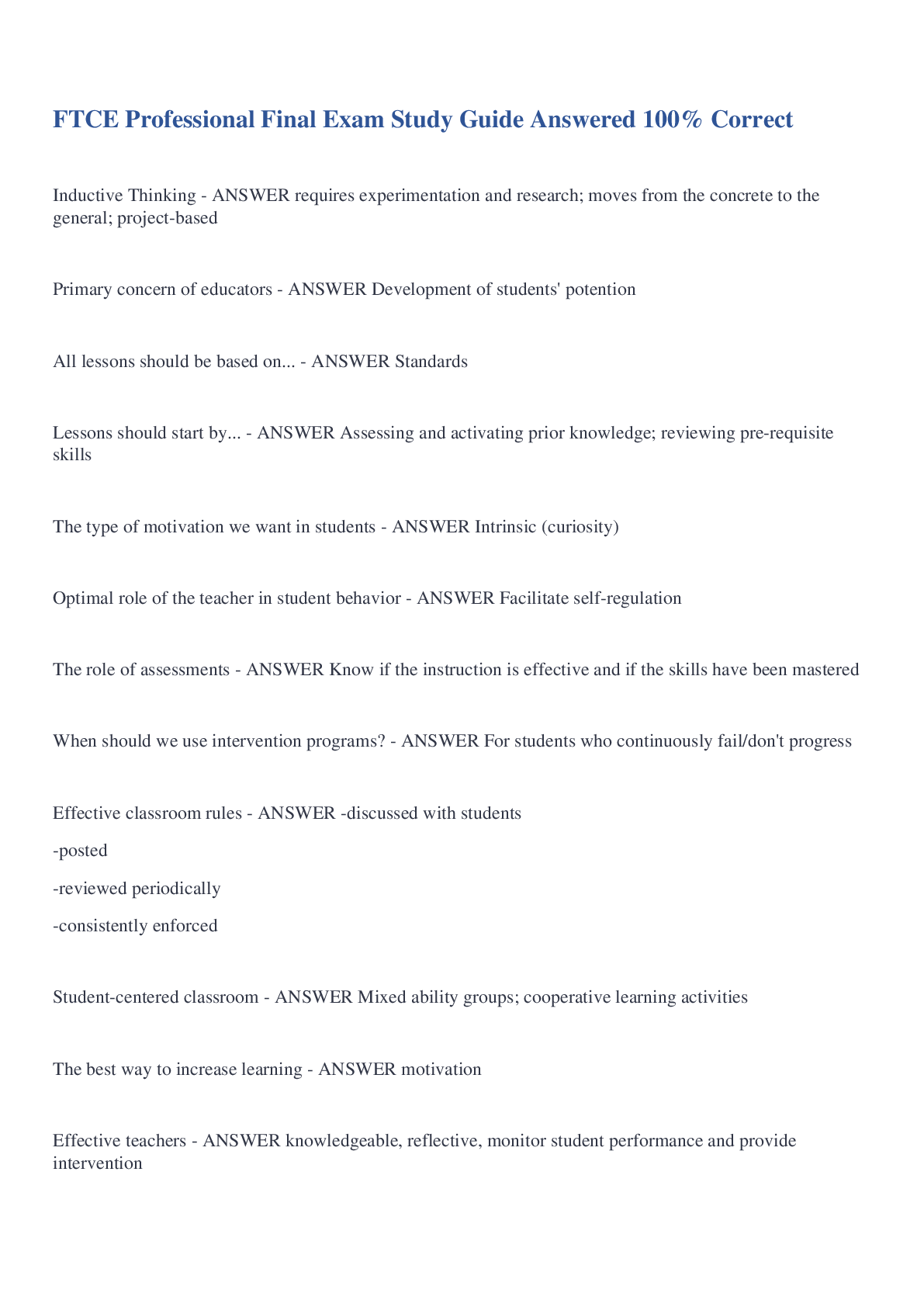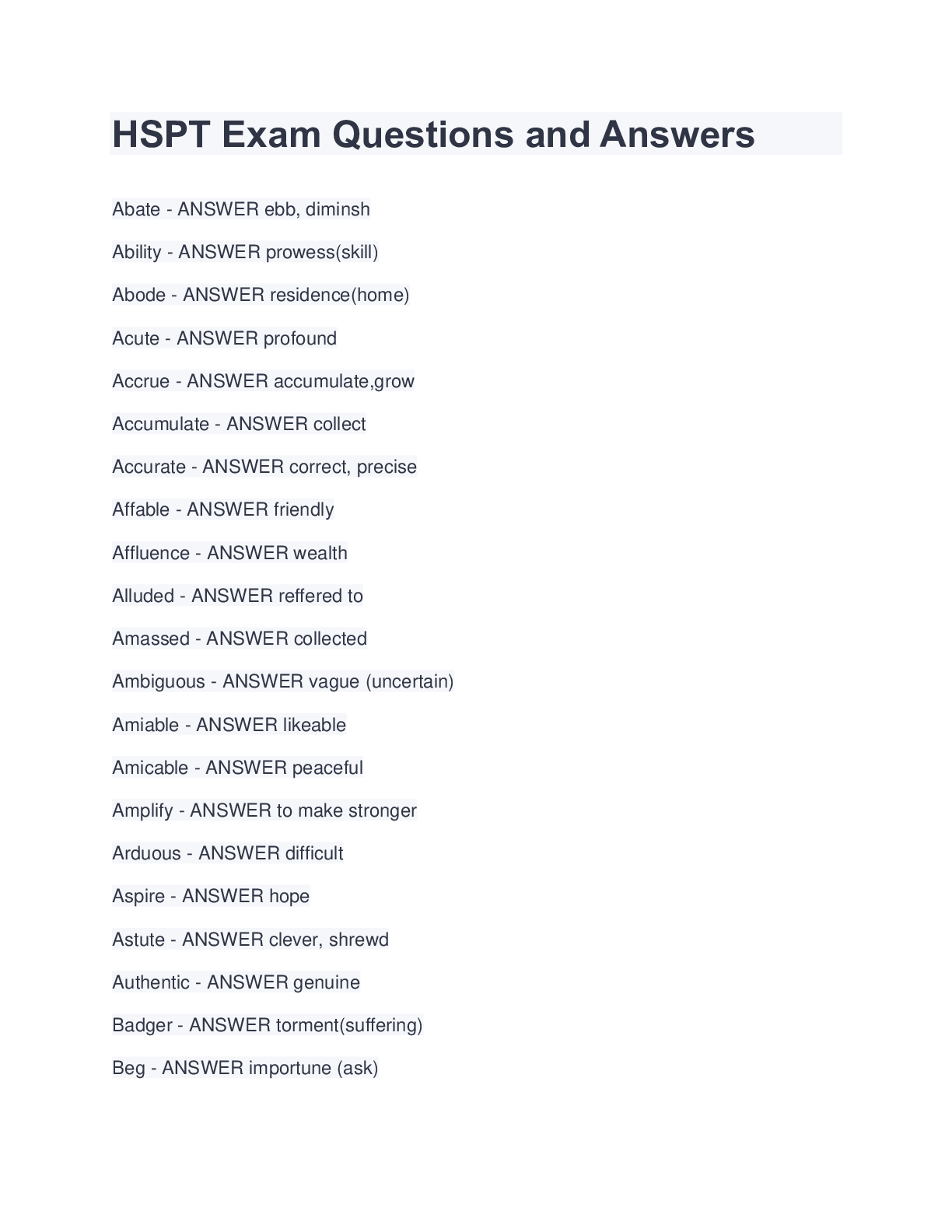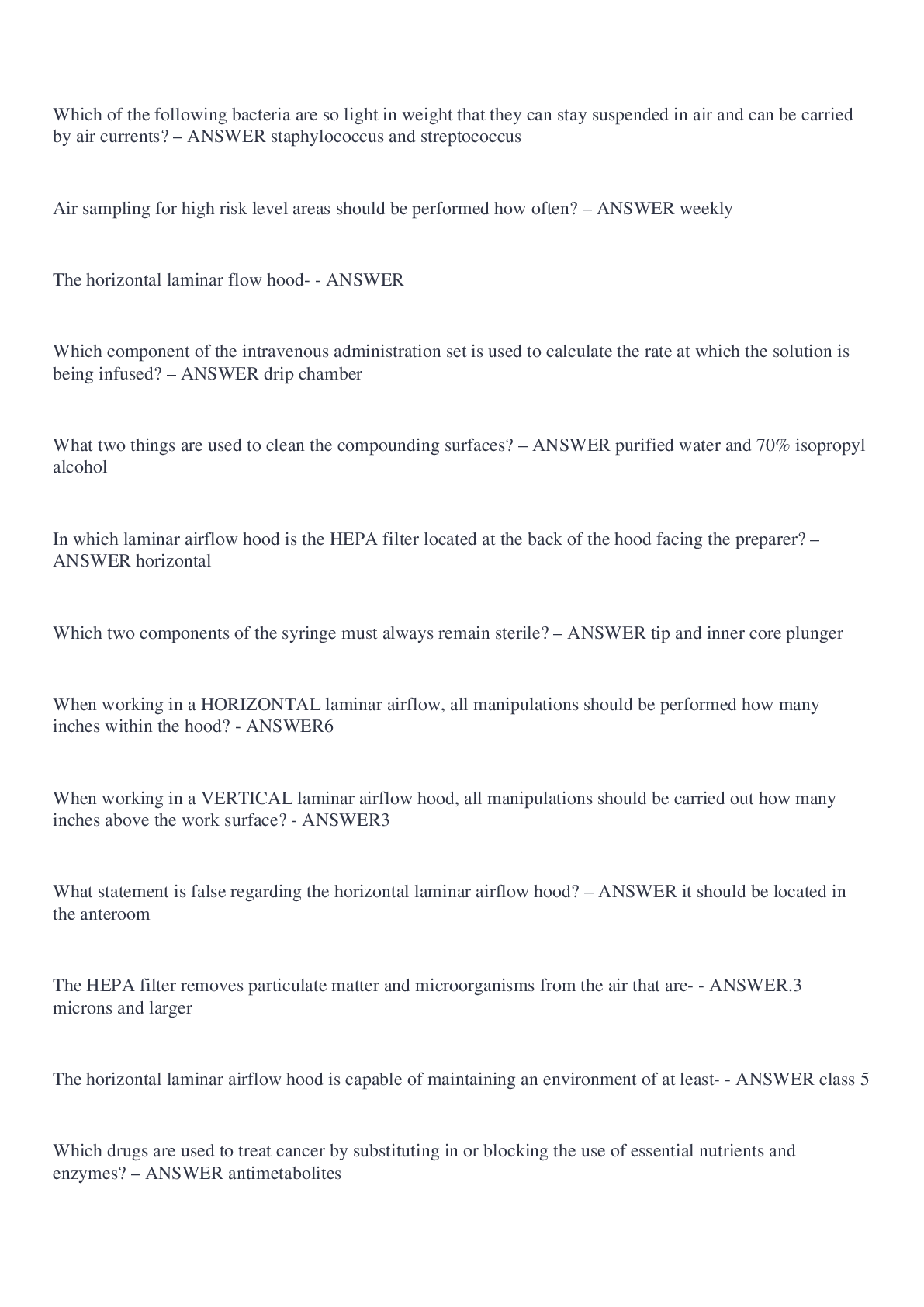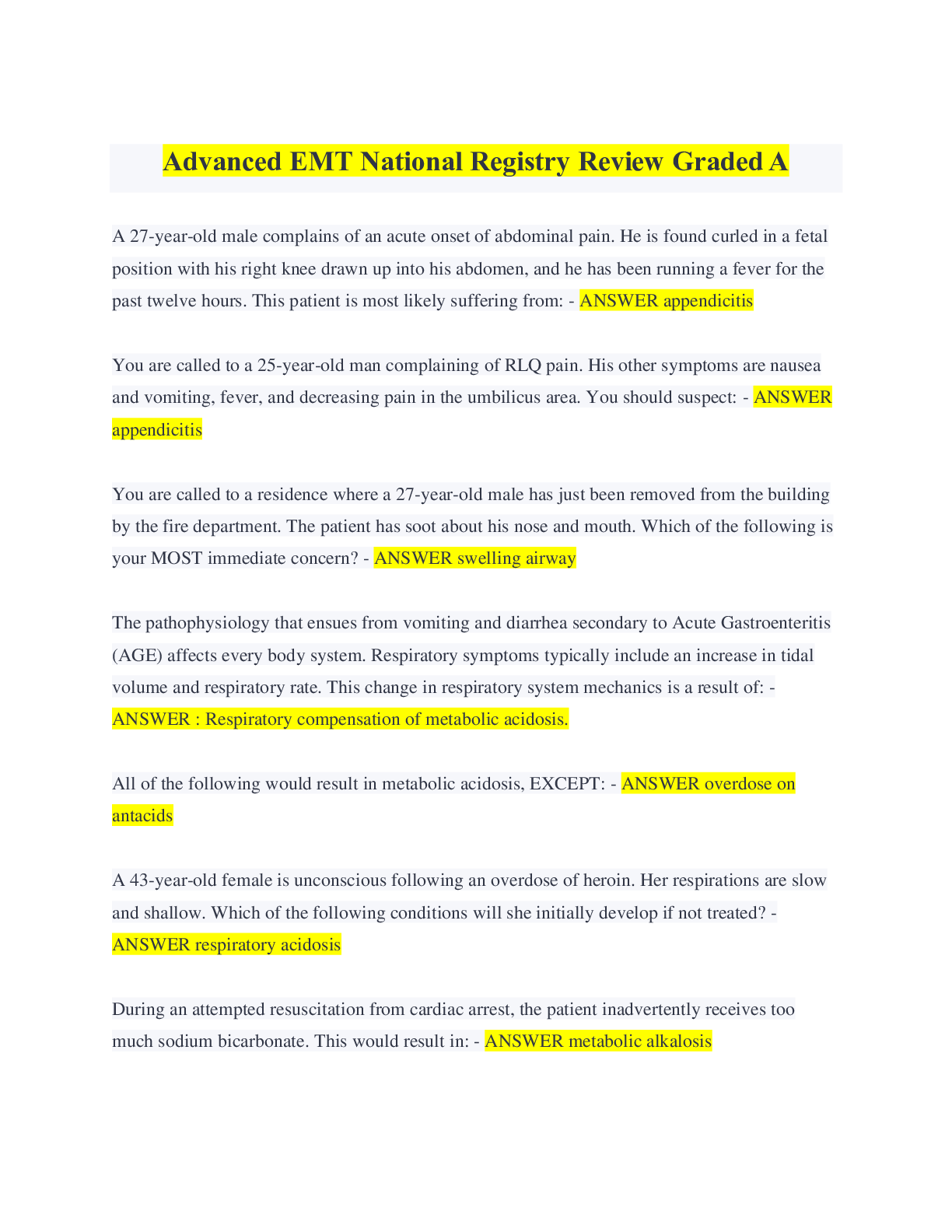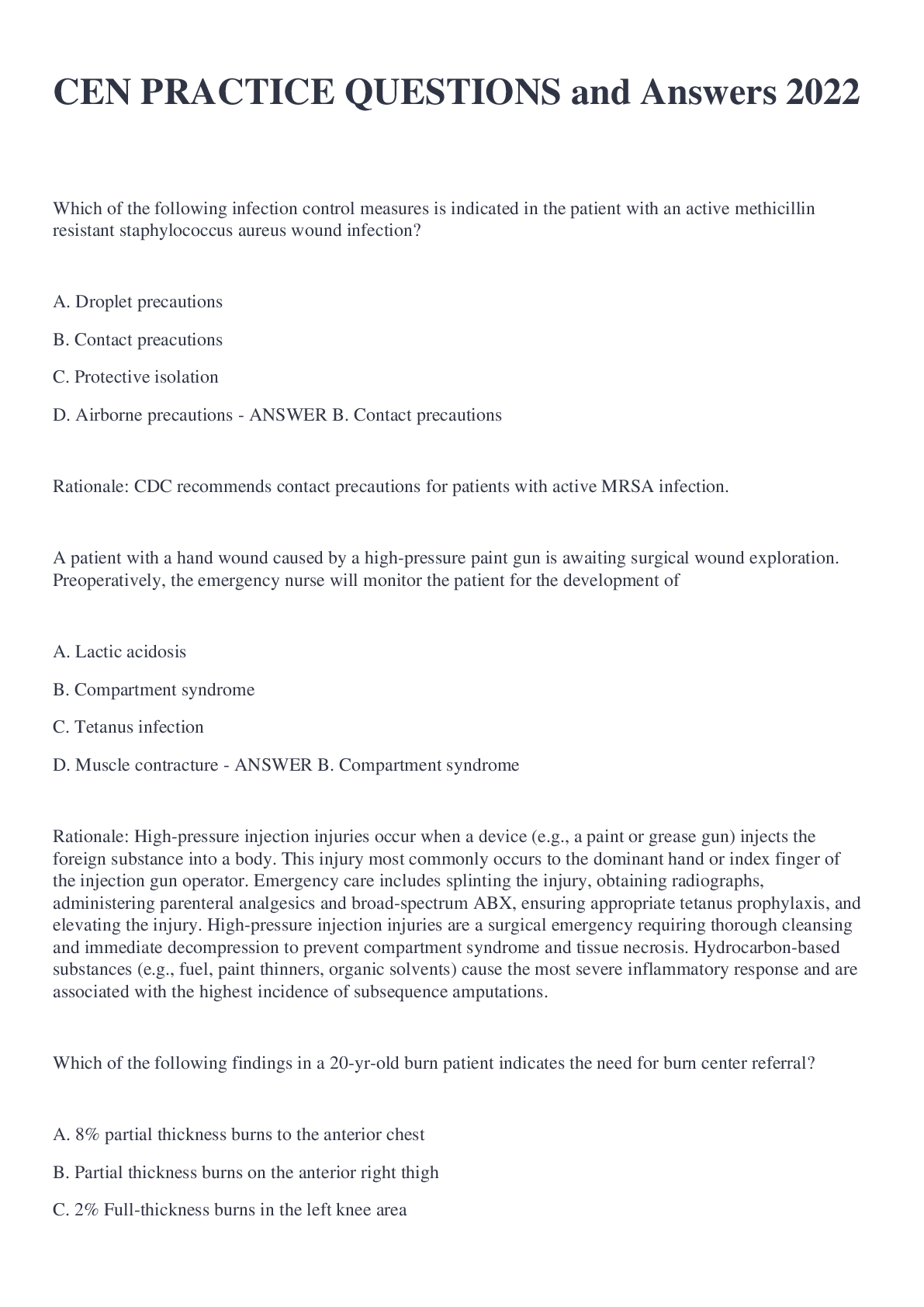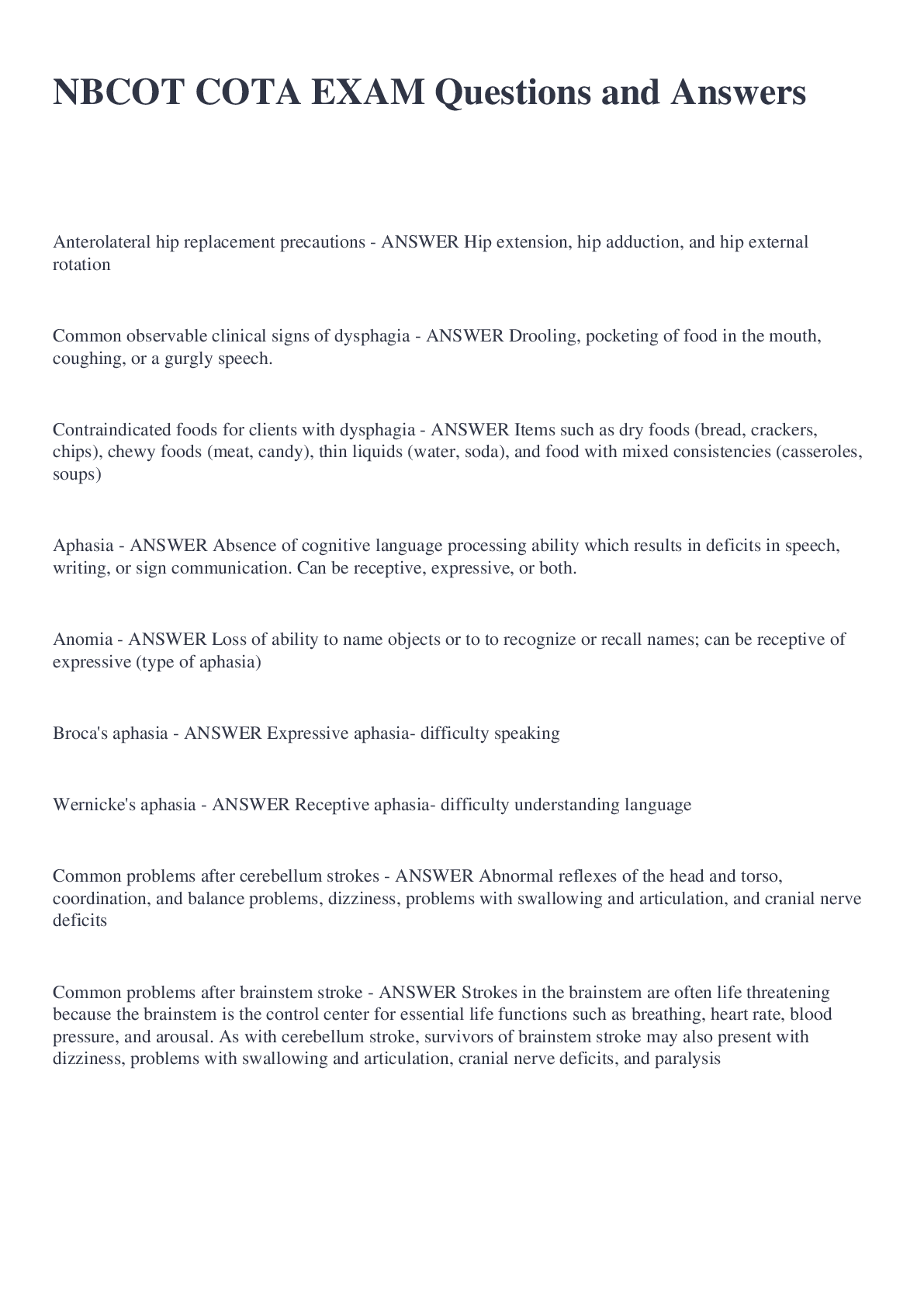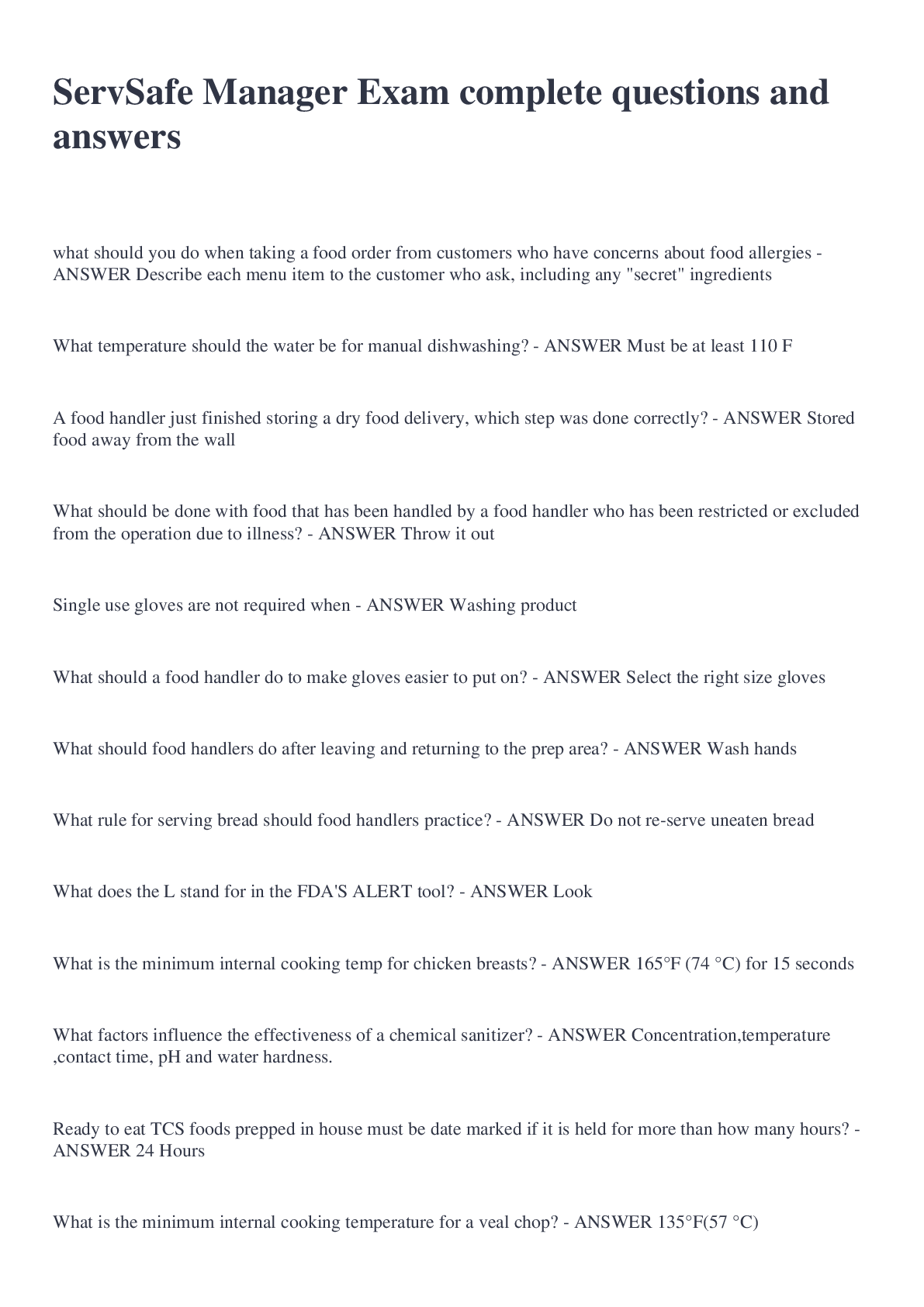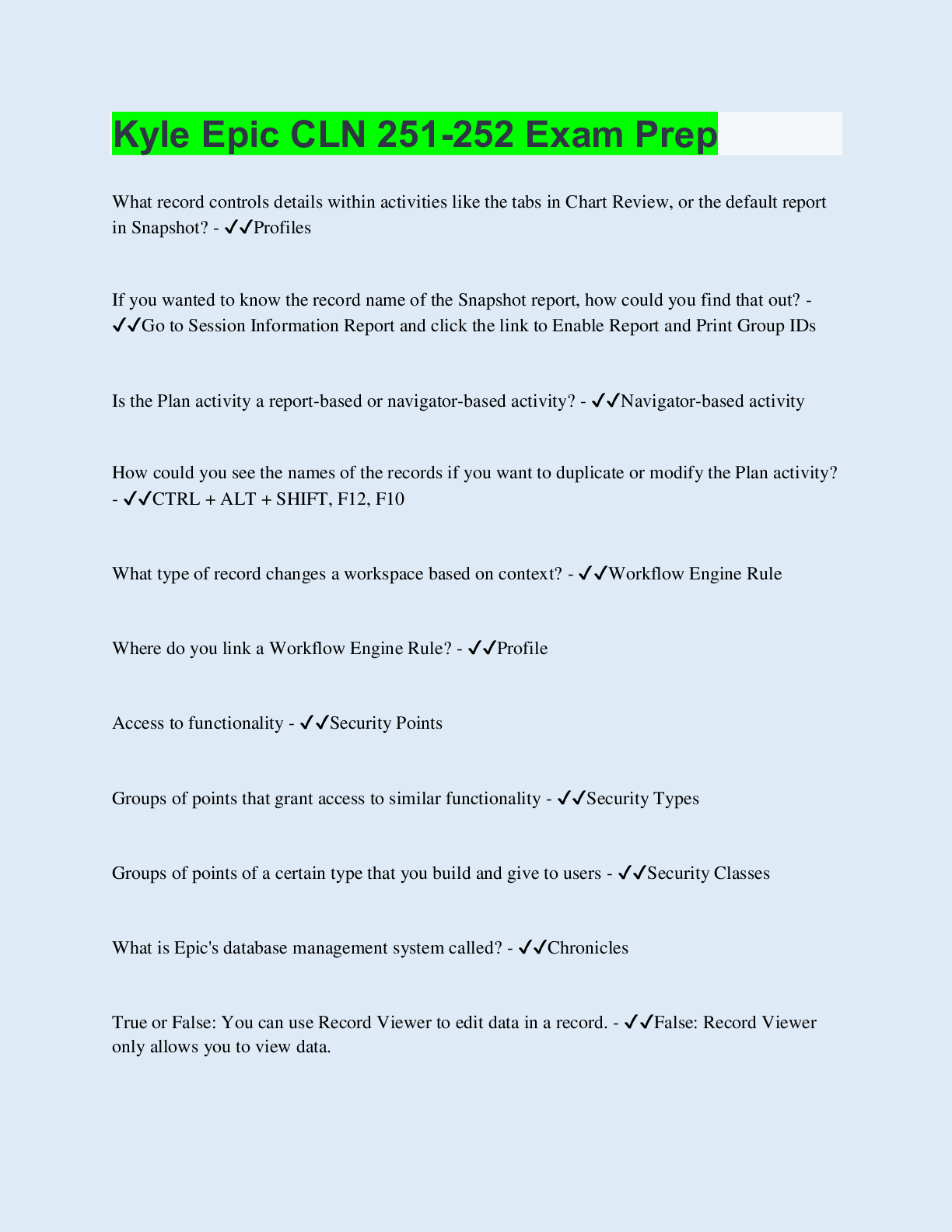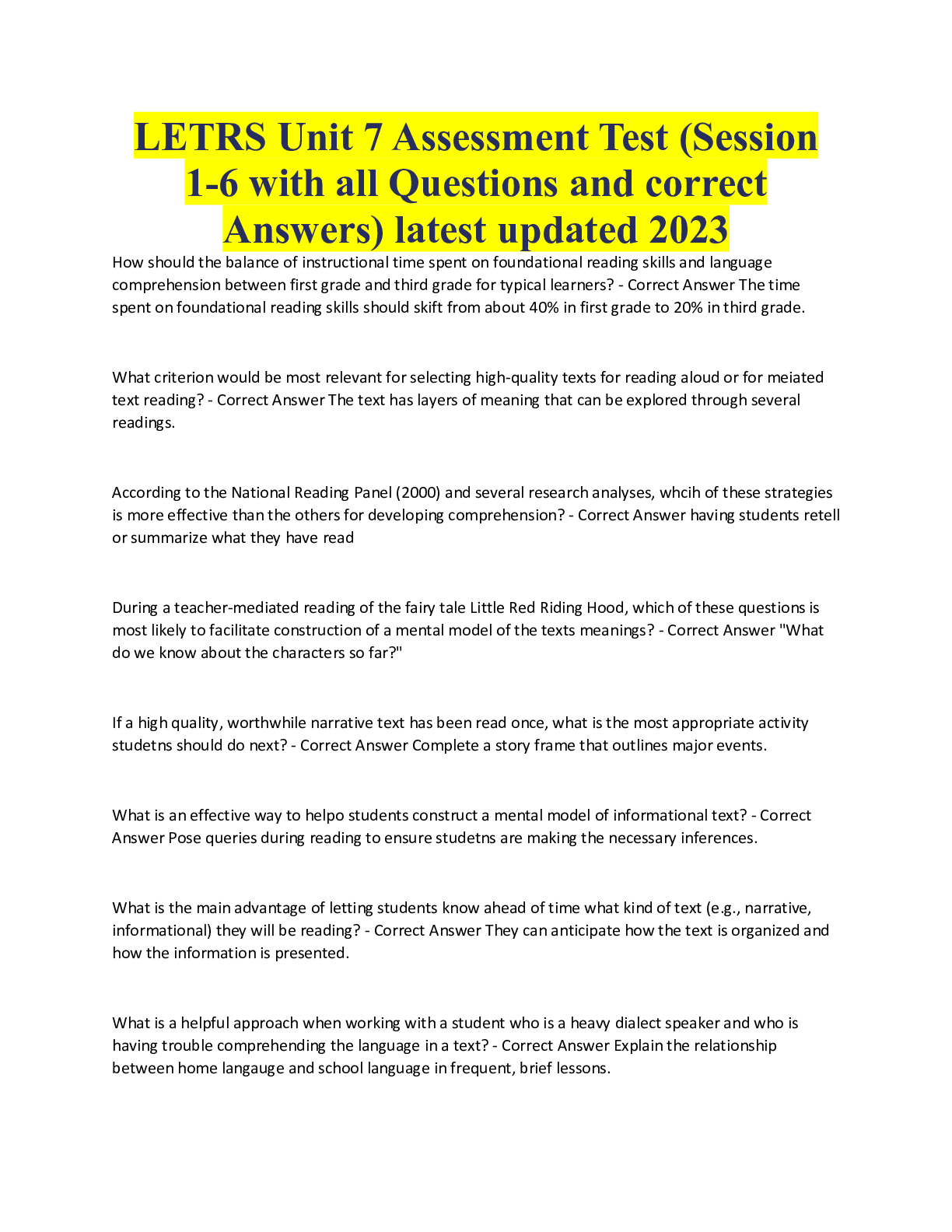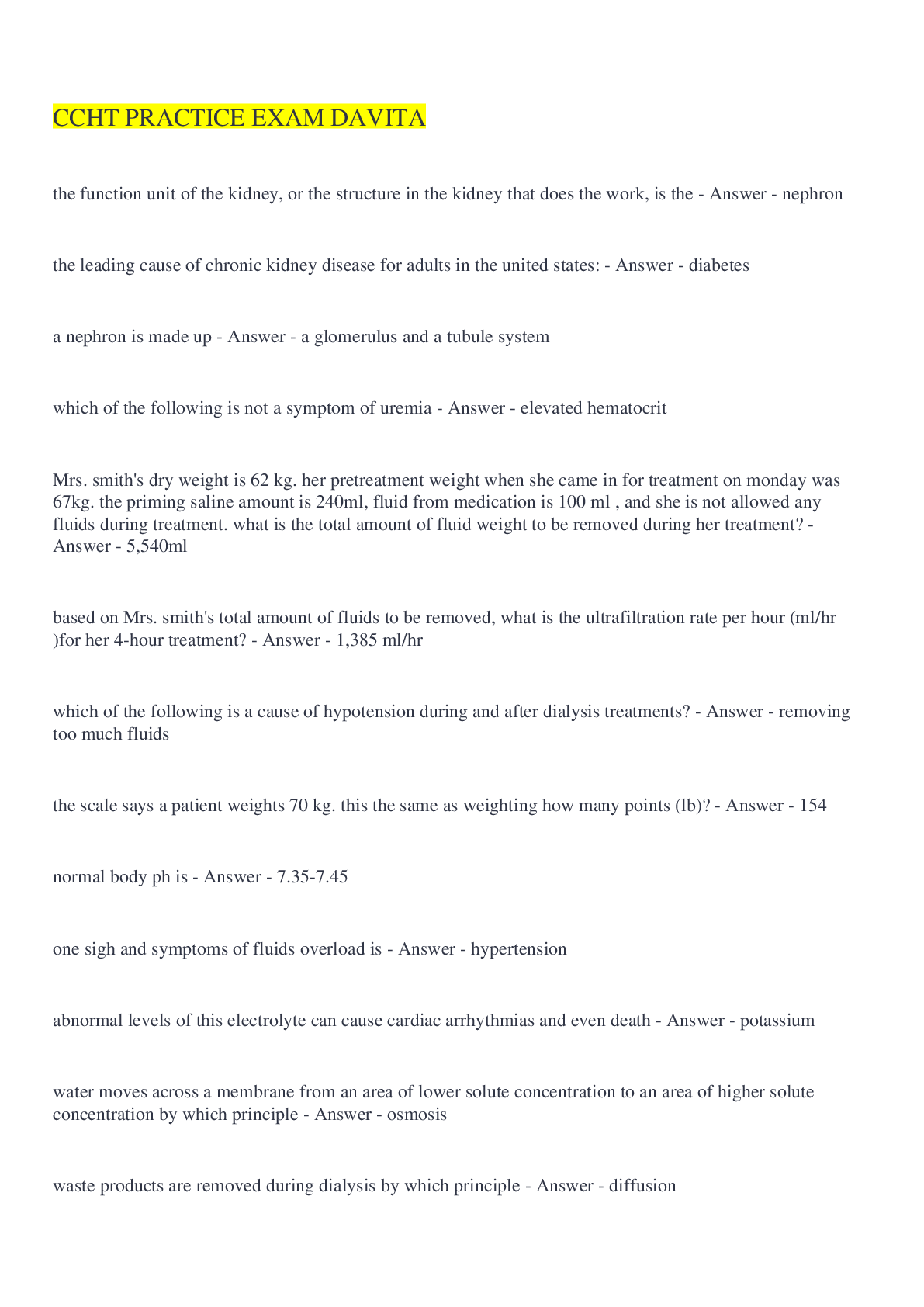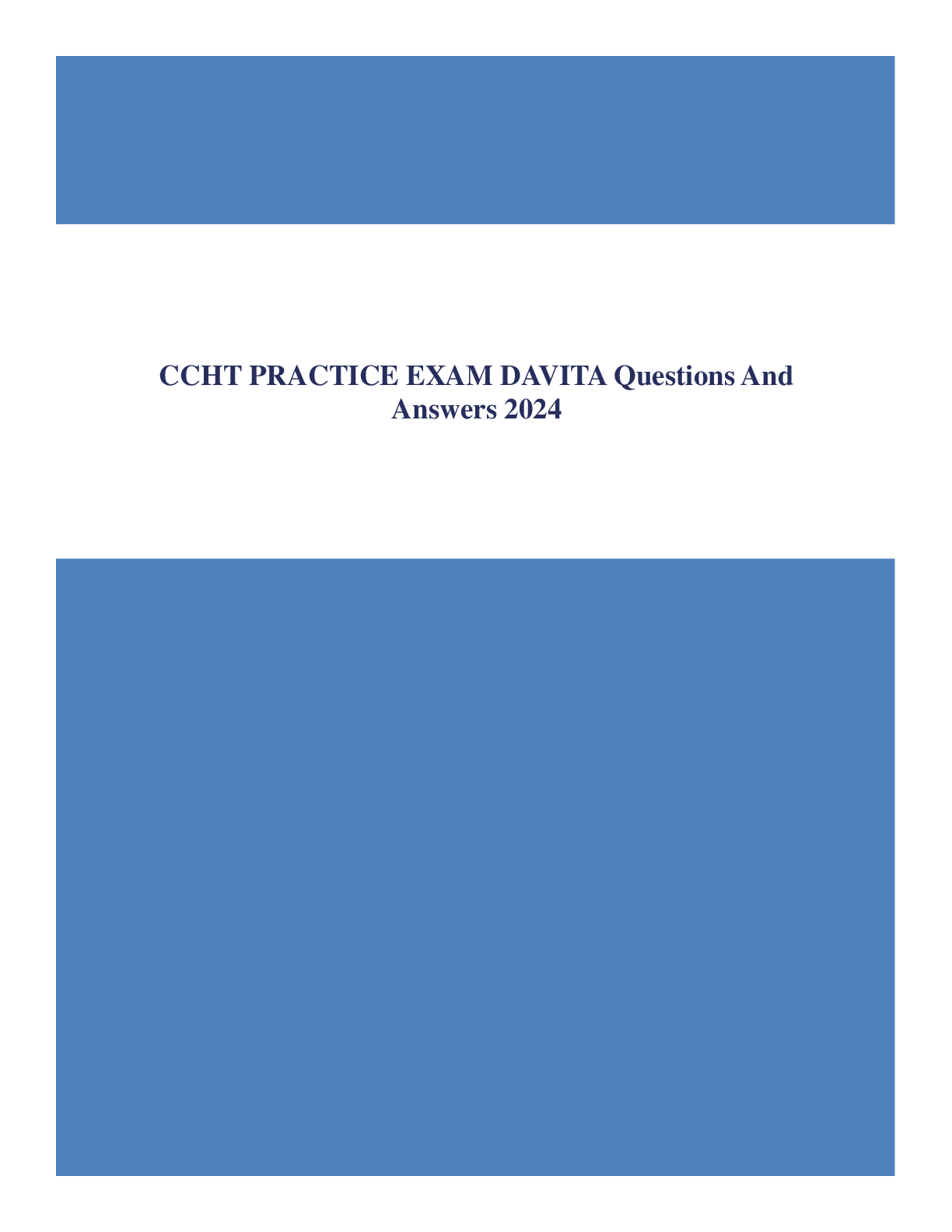CCHT PRACTICE EXAM DAVITA Questions and Answers
Document Content and Description Below
the function unit of the kidney, or the structure in the kidney that does the work, is the - ANSWER nephron the leading cause of chronic kidney disease for adults in the united states: - ANSWER dia... betes a nephron is made up - ANSWER a glomerulus and a tubule system which of the following is not a symptom of uremia - ANSWER elevated hematocrit Mrs. smith's dry weight is 62 kg. her pretreatment weight when she came in for treatment on monday was 67kg. the priming saline amount is 240ml, fluid from medication is 100 ml , and she is not allowed any fluids during treatment. what is the total amount of fluid weight to be removed during her treatment? - ANSWER 5,540ml based on Mrs. smith's total amount of fluids to be removed, what is the ultrafiltration rate per hour (ml/hr)for her 4-hour treatment? - ANSWER 1,385 ml/hr which of the following is a cause of hypotension during and after dialysis treatments? - ANSWER removing too much fluids the scale says a patient weights 70 kg. this the same as weighting how many points (lb)? - ANSWER 154 normal body ph is - ANSWER 7.35-7.45 one sigh and symptoms of fluids overload is - ANSWER hypertension abnormal levels of this electrolyte can cause cardiac arrhythmias and even death - ANSWER potassium water moves across a membrane from an area of lower solute concentration to an area of higher solute concentration by which principle - ANSWER osmosis waste products are removed during dialysis by which principle - ANSWER diffusion excess fluid is forced out of the blood and into the dialysis by which principle - ANSWER ultrafiltration the movement of the fluid from the tissue toward a higher concentration of sodium in the blood is a example of - ANSWER osmosis decreasing the patient's prescribed blood flow affects the rate of - ANSWER diffusion which of the following actions would increase diffusion during dialysis? - ANSWER using a bath that will provide a grater concentration gradient which of the following diffusion diffuses from the patients blood during dialysis? - ANSWER urea ultrafiltration is influenced by - ANSWER transmembrane pressure the most common complication in peritoneal dialysis is - ANSWER peritonitis the dextrose used in the dialysate for peritoneal dialysis can cause - ANSWER hyperglycemia if a patient develops an infection post transplant, the largest contributing factor would most likely be: - ANSWER immunosuppressive medication the most frequent cause of death in the first year post transplant is - ANSWER infection total cell volume (TCV) is a indirect measure of the - ANSWER performance of the dialyzer the TCV should be no less than - ANSWER 80% the manimum dwell time to achieve sterilization with the chemical renalin is - ANSWER 11 hours the reprocessed dialyzer is carefully rinsed prior to patient use to remove - ANSWER residual sterilant germicide rebound occurs due to - ANSWER inadequate dialyzer priming which organization set the standards and recommendations for dialyzer reprocessing? - ANSWER AAMI the blood path integrity is tested to eliminate the possibility of a blood leak. the drop in pressure should not exceed: - ANSWER 10 mmhg the purpose of using counter-current flow is to - ANSWER increase the rate of waste removal the total pressure that exists across the dialyzer membrane is called - ANSWER transmembrane pressure dialyser ph should be - ANSWER between 7.0 and 7.4 dialyzer that is too hot will cause - ANSWER hemolysis which of the following component in dialysate is used to correct metabolic acidosis? - ANSWER bicarbonate total chlorine levels in the water are tested - ANSWER before each patient shift or every four hour the water softener removes - ANSWER calcium and magnesium AAMI standars for the total microbial count of dialysate shall not exceed - ANSWER 200 CFU/ML the water softener - ANSWER operates on the principle of ion exchange which of the following is considered to be safe water for dialysis - ANSWER dialysis quality water patient expose to chloramines during the hemodialysis treatment may cause - ANSWER hemolysis according to AAMI the standard levels for endotoxin levels is - ANSWER less than two (2) EU/ML. feed conductivity- product conductivity divided by x 100 is the formula calculation of - ANSWER percent rejection a mixed-bed DI tank contains - ANSWER cations and anions the substance that may be added to the municipal drinking water to make it clearer is - ANSWER aluminum AAMI chemical analysis of water used for hemodialysis is tested - ANSWER annually the part of the cell wall of bacteria that, when released, can cause fever in hemodialysis patients is - ANSWER endotoxin during a hemodialysis treatment the technician responds to a low venous pressure alarm. the most likely cause for this alarm - ANSWER disconnection of the blood line the hemodialysis machine continuously monitors may parameters. which of the these parameters must be verified by an external measuring device? - ANSWER ph and conductivity which of the following is most likely to cause a high venous pressure alarm? - ANSWER kinking of the venous blood line during the set-up of a hemodialysis machine, the alarm test for conductivity fails. which of these actions should the dialysis technician take? - ANSWER notify the equipment technician rinse in transmembrane pressure in a low flux dialyzer during hemodialysis is indicative of - ANSWER clotting of the extrecorporeal circuit one reason that normal saline is used to rinse and prime the extracorporeal circuit prior to treatment is to remove - ANSWER air which of the following best describes the transducer protector? - ANSWER device inside the machine that converts air pressure into electronic signal which of the following would cause a high venous pressure alarm? - ANSWER venous needle is against the wall of the vessels the air detector alarms during treatment. if the machine is working properly, the dialysis technician should expect which of these events to have occurred - ANSWER blood pump has stopped the extracorporeal circuit consists of the - ANSWER blood lines and the dialyzer before a hemodialysis treatment , treatment , the technician removes the cap from the fistula needle and accidentally touches the chair with the tip of the needle. which of these actions should the technician take first - ANSWER discard the needle to determine the potency of a arteriovenous vascular access, the dialysis technician should initially feel for the presence of - ANSWER a thrill a patient complaints of pain at the venous needle site. the dialysis technician observes there is swelling distal to the venous needle site and that the venous pressure is rising. the dialysis technician should suspect - ANSWER an infiltration all the following may be signs and symptoms of an infection access EXCEPT: - ANSWER numbness and tingling during a hemodialysis treatment, a patient's venous needle infiltrates. which of these actions should the dialysis technician take first? - ANSWER stop the blood pump which of these types of vascular access has the fewest complication - ANSWER an arteriovenous fistula one disadvantage of a fistula is an increase in - ANSWER in time to mature one cause of aneurysm and pseudo aneurysm is - ANSWER poor rotation of sites what is the desired outcome when the patient performs fistula exercise? - ANSWER enlargement of the vein the bruit in an AV fistula or graft is detected by - ANSWER listening with a stethoscope when cannulating, the tips of the needles should be at least - ANSWER 2.0 inches apart the venous needle in an AV fistula - ANSWER should point in the direction of the blood flow a true aneurysm can be dangerous because it - ANSWER may rupture and cause the patient to bleed profusely a fistula connects - ANSWER an artery to a vein prior to cannulation a technician notices the skin over the patient's fistula is reddened and warm to touch. these symptoms are most likely due to - ANSWER infection during predialysis data collection, it would be best for the technician to ask the patient which of these questions? - ANSWER how have you been since your last dialysis treatment? Mrs. pruitt's temperature is elevated post-hemodialysis treatment. which of these actions should the dialysis technician take? - ANSWER notify the nurse Mrs. smith arrives for dialysis treatment complaining of shortness of breath. her pre-dialysis weight is 4.7 kilograms above the last post-treatment weight. the dialysis technician reweighed and verified the weight. which of the actions should the dialysis technician take next? - ANSWER notify the nurse of the need for an assessment slow pulse of 54 beats/minute would indicate the patient has: - ANSWER bradycardia during hemodialysis, the air detector on Ms. foster's machine alarms and foam is visible in the venous drip chamber. the immediate action of the dialysis technician should be to. - ANSWER clamp the venous line dry weight is defined as the - ANSWER weight at which the patient has no edema or fluids in the lungs and bp is normal which of the following symptoms would indicate a need to increase the estimated dry weight (EDW)? - ANSWER hypotension and cramping Sam's EDW is 70 kilograms (KG). he arrives for treatments today at a weight of 70kg. he complains of shortness of breath and you notice his ankles are swollen. you notify the charge nurse. what do you think will be the plan for sam's treatments todays? - ANSWER the nurse will get an order to decrease the EDW which of the following is not a possible cause of an increased temperature pre-dialysis? - ANSWER the patient has fluid overload which of the following is the classic sign of hemolysis - ANSWER cranberry juice colored blood in the venous line Ms. foster complication of shortness of breath. while calling for the nurse the dialysis technician notices there is air in the extracorporeal circuit she/he should place Ms. foster in: - ANSWER trendelenburg position on left side solution that have a higher osmolarity than body fluids are called? - ANSWER hypertonic the most important intervention to prevent the spread of infection is: - ANSWER cleansing of the hands infection control protocol for hemolysis equipment should include which of these actions by the caregiver? - ANSWER using gloves when touching the machine when fluid replacement is necessary during the hemodialysis treatment, which of the following solution is used? - ANSWER 0.9% normal saline a patient's dry weigh is 154.0 lb (70 kg) and the patient's pre treatment weight is 158.4 lb (72kg). four-hours treatment, how many ml/hour must the patient lose to reach dry weight? - ANSWER 500 during a hemodialysis treatment, a patient says to the technician, three hours of time have passed according to the clock on the wall, but the machine shows that only 2.5 hours have passed. what could be the problem? the technician should understand that the. - ANSWER machine was in bypass for 30 minutes a dialysis technician observes a drop of blood on the surface of a patient's hemolysis machine. which of these actions should the dialysis technician take? - ANSWER clean the machine surface immediately asepsis is defined as - ANSWER the absence of disease producing organism if the extracorporeal circuit clots and it must be discarded, it would be most important to monitor the patient's serum levels of - ANSWER hemoglobin what are the typical signs of fluids overload - ANSWER edema and shortness of breath hyperkelemia can lead to - ANSWER cardiac arrest which of the following is used to prevent air in the bloodlines? - ANSWER tighten all connections fifteen minutes before the end of a hemodialysis treatment, a patient complains of dizziness and nausea. these symptoms are most likely due to - ANSWER hypotension during the hemodialysis treatment, a patient complains of feeling chilled. in addition to getting the blanket, which of these actions should the technician take? - ANSWER take the patient's temperature short frequent hemodialysis treatment in patients with high BUN ( blood urea nitrogen ) are performed to prevent - ANSWER dialysis disequilibrium syndrome during hemolysis a patient goes into cardiac arrest. the first action of the dialysis technician should be? - ANSWER call for assistance a patient who is to receive their first dialysis treatment is prone to - ANSWER dialysis disequilibrium syndrome fluid to be removed divided by the treatment time tells us - ANSWER the ultrafiltration rate the normal range of resting respirations in an adult is: - ANSWER 12-20 breaths per minute hives, itching, tightness of the chest and respiratory distress may be signs and symptoms of: - ANSWER anaphylaxis (severe allergic reaction) pain at the venous needle site, along with respiratory difficulty and chest pain could be an indicator of: - ANSWER sterilant infusion a rapid pulse of 104 beats/minute would indicate that the patient has: - ANSWER tachycardia a marker used to determinate the middle molecule clearance of a dialyzer is - ANSWER vitamin B12 the national standard, based on the KDOQI ( kidney disease outcomes quality initiative ) guidelines, for the urea reduction rate ( URR) is a ratio greater than : [Show More]
Last updated: 2 years ago
Preview 1 out of 12 pages

Buy this document to get the full access instantly
Instant Download Access after purchase
Buy NowInstant download
We Accept:

Reviews( 0 )
$7.00
Can't find what you want? Try our AI powered Search
Document information
Connected school, study & course
About the document
Uploaded On
Oct 06, 2022
Number of pages
12
Written in
Additional information
This document has been written for:
Uploaded
Oct 06, 2022
Downloads
0
Views
69

